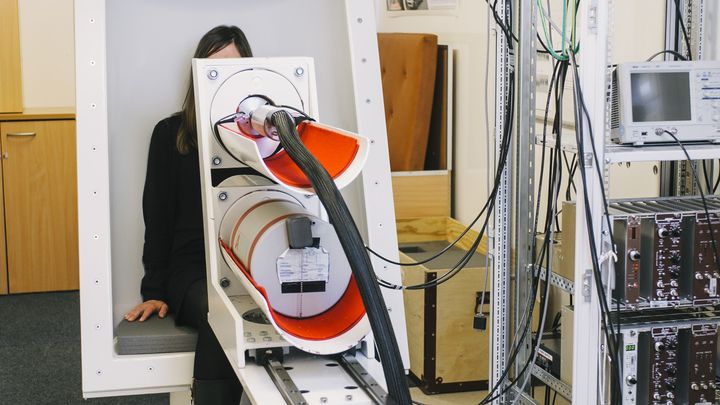Radiation and Nuclear Safety Authority measures human radioactivity in Rovaniemi
Human radioactivity measurements to be carried out by the Radiation and Nuclear Safety Authority in Rovaniemi are part of the programme to measure the radioactivity of the population, which began in the 1960s.

The box truck parked in front of the main door of the Rovaniemi campus of the University of Lapland from Monday, 8 April to Thursday, 11 April, will reveal what radioactive substances are in the human body and how much radiation the human body emits.
Volunteer students and staff from the University of Lapland and the Lapland University of Applied Sciences have been invited to participate in the measurements that will take fifteen minutes.
STUK also carries out similar measurements in Helsinki and Tampere. On the basis of the measurements, STUK calculates the radiation doses that Finns receive from radioactive substances in themselves and how much of the substances and doses comes from man-made substances.
Reindeer breeders were measured first
The first group called to population measurements in Finland were reindeer breeders in Northern Lapland, and the first measurements were carried out in 1962. At that time, radioactive materials from nuclear weapons detonated in the atmosphere landed along with the rains, especially in the north. Lichens effectively collected radioactivity and, through reindeer, it accumulated especially in reindeer breeders who ate a lot of reindeer meat.
Nuclear weapons tests have not been carried out in the atmosphere in the north since 1963, and the last nuclear weapon explosion in the atmosphere in general dates back to 1980. Today, the radioactivity of reindeer breeders is no different from that of the rest of the population. This is also influenced by the diversification of reindeer breeders’ diets.
However, there are still very small but measurable amounts of radioactive substances in Finnish nature, both from nuclear weapons tests and from the Chernobyl accident of 1986. Of these, the most significant is the caesium isotope 137.
There is no need to worry about the radiation dose caused by caesium-137. It is less than one-thousandth of the total annual average dose received by Finns from various sources and has no impact on human health.
Most of the radiation dose received by Finns is due to various external sources, and not the radioactivity inside the body. Indoor radon gas in homes and workplaces causes most of the radiation received by Finns.
Keywords
Contacts
Media contacts
Tel:+358(10)8504761Subscribe to releases from Säteilyturvakeskus (STUK)
Subscribe to all the latest releases from Säteilyturvakeskus (STUK) by registering your e-mail address below. You can unsubscribe at any time.
Latest releases from Säteilyturvakeskus (STUK)
Radioaktiva ämnen fortsätter att minska4.7.2025 09:57:23 EEST | Pressmeddelande
Strålsäkerhetscentralens årsrapport Strålningsövervakning av miljön i Finland berättar vilka radioaktiva ämnen som inte ursprungligen hörde till naturen som hittades år 2024, var de påträffades och i vilka mängder de förekommer i miljön.
Radioaktiivisten aineiden määrä yhä laskussa4.7.2025 09:57:23 EEST | Tiedote
Säteilyturvakeskuksen julkaisema Ympäristön säteilyvalvonta Suomessa -vuosiraportti kertoo, mitä luontoon alun perin kuulumattomia radioaktiivisia aineita vuonna 2024 löytyi, mistä niitä löytyi ja kuinka paljon niitä ympäristössä on.
Delta i forskningen – skicka in ditt svampprov till Strålsäkerhetscentralen23.6.2025 14:58:25 EEST | Pressmeddelande
Strålsäkerhetscentralen ordnar kampanjen Svamp 2025 som pågår från juli till slutet av november. Syftet med kampanjen är att utreda halterna av radioaktivt cesium (Cs-137) i matsvampsarter och skillnader i dessa halter i olika delar av landet och i olika svamparter. Under kampanjen kan du skicka prover på matsvamp från hela landet till Strålsäkerhetscentralen.
Tule mukaan tieteen tekemiseen - lähetä ruokasieninäyte Säteilyturvakeskukseen23.6.2025 14:58:25 EEST | Tiedote
Säteilyturvakeskus järjestää heinäkuusta marraskuun loppuun asti kestävän Sienet 2025 -kampanjan, jossa on tarkoitus selvittää ruokasienilajien radioaktiivisen cesiumin (Cs-137) pitoisuuksia ja pitoisuuseroja maan eri osissa ja eri sienilajeissa. Kampanjan aikana on mahdollista lähettää ruokasieninäytteitä ympäri maata Säteilyturvakeskukseen.
Take part in scientific research – Submit an edible mushroom sample to the Radiation and Nuclear Safety Authority23.6.2025 14:58:25 EEST | Press release
From July until the end of November, the Radiation and Nuclear Safety Authority will organise the Mushrooms 2025 campaign, the aim of which is to examine radioactive cesium (Cs-137) concentrations and differences in concentrations in edible mushroom species in different parts of the country and in different mushroom species. During the campaign, the public can send edible mushroom samples from all over the country to the Radiation and Nuclear Safety Authority.
In our pressroom you can read all our latest releases, find our press contacts, images, documents and other relevant information about us.
Visit our pressroom